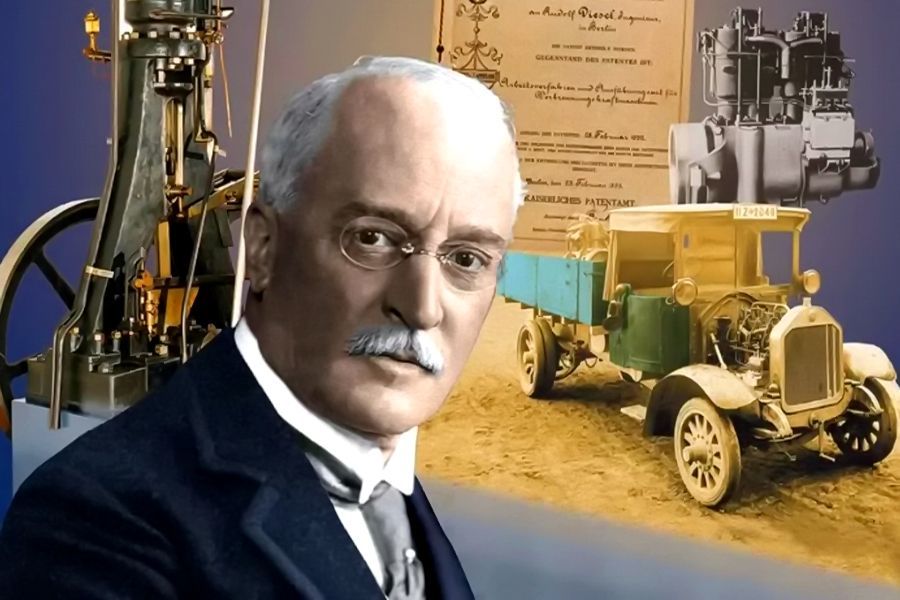Rudolf Diesel, a German inventor and mechanical engineer, is famous for his invention of the diesel engine and for the mysterious circumstances surrounding his death. In 1942, a film titled “Diesel” was made about his life.

Early Life Of Rudolf Diesel
Rudolf Diesel was born in 1858 in Paris, France, the second of three children of Elise and Theodor Diesel. Theodor was a leather goods manufacturer, but the family struggled financially. As a child, Diesel worked in his father’s workshop and delivered goods using a barrow. Despite these challenges, he was known as a bright and accomplished student in school.
In 1870, the Diesel family, like many German families, were forced to flee Paris due to the outbreak of the Franco-Prussian War. Theodore Diesel, a German national originally from Augsburg, Bavaria, had moved to Paris in 1848. They eventually settled in London, England, where Rudolf Diesel attended school.
Before the war ended, Rudolf’s mother sent him to Augsburg at the age of 12 to live with his aunt and uncle, Barbara and Christoph Barnickel. At 14, Diesel wrote a letter to his parents expressing his desire to become an engineer, which he eventually achieved.
The Diesel Engine – An Unforgettable Invention Of Rudolf Diesel
Diesel began his career in refrigeration and ice plant design, but in the 1890s expanded to other fields. He first worked with steam engines, and his research led him to build an engine using ammonia vapor, which unfortunately exploded during a test and almost killed him. He suffered health and vision problems as a result of the incident, and spent months in the hospital.
Later, Diesel focused on developing a more efficient heat engine to replace the steam and combustion engines of the time. This led to the successful creation of the first diesel engine in 1897, which is now on display at the German Technical Museum in Munich.

Despite obtaining patents for his design in various countries, including Germany and the United States, Rudolf Diesel did not live to see the widespread success of his invention. He died unexpectedly in 1913, just as the use of diesel engines was beginning to increase globally.
Disappearance And Death Of Rudolf Diesel
On September 29, 1913, Rudolf Diesel went missing from the steamship Dresden during a voyage from Antwerp, Belgium to Harwich, England. He had boarded the post office steamer in Antwerp en route to a meeting of the Consolidated Diesel Manufacturing company in London.
Diesel had dinner on board and retired to his cabin around 10 PM, leaving word to be called at 6:15 AM the next morning. However, he was never seen alive again. The next morning, his cabin was empty and his bed unused, but his nightshirt was laid out and his watch visible on the bedside table. His hat and overcoat were found folded under the deck railing.
Ten days after Diesel’s disappearance, the crew of the Dutch vessel Coertsen found a corpse floating in the North Sea near Norway. The body was too decomposed to be identified, so the crew instead retrieved personal items from the clothing, such as a pill case, wallet, ID card, pocketknife, and eyeglass case, and returned the body to the sea. On October 13th, these items were identified by Diesel’s son, Eugen, as belonging to his father. On October 11th, a report emerged that Diesel’s body had been found at the mouth of the Scheldt by a boatman, but was thrown overboard due to heavy weather.
Rudolf Diesel’s death remains a mystery with various theories surrounding it. Some, like his biographer Grosser in 1978, believe that he committed suicide, while others suggest that he may have been murdered due to his refusal to grant German forces exclusive rights to his invention. However, there is limited evidence to support any of these explanations, and the cause of his death remains unsolved.
This led to speculation that Diesel’s death may have been financially motivated, as he may have been facing financial difficulties. However, without concrete evidence, the true reasons behind his death remain a mystery.
It should be noted that the circumstances surrounding Diesel’s death, including the discovery of a cross in his diary and the large sum of money found in his wife’s possession, have led to speculation and various theories about the cause of his death. Some believe that he committed suicide, while others suggest that he may have been murdered, possibly due to his refusal to grant exclusive rights to his invention to the German military. However, there is limited evidence to support any of these theories, and the true cause of Diesel’s death remains unknown.
Conclusion:
Diesel engines had a significant global presence by 1912, primarily in industrial settings and as generators. Over time, the engine developed by Diesel, revolutionized the railroad industry. Following World War II, diesel engines were also incorporated into trucks and buses, allowing for more efficient transport of heavy loads.
Rudolf Diesel’s sudden disappearance created confusion and shock. He was perceived to be a successful inventor and businessman due to his numerous patents. However, after his death was confirmed and the circumstances of his disappearance were investigated, it was revealed that he had been struggling financially due to poor investments and poor health. His death was officially ruled as suicide, but the mysterious nature of the event kept Diesel in the news for years to come.
Rudolf Diesel’s death, while en route to England for a new diesel-engine plant opening and submarine engine talks with the British navy, led to conspiracy theories. Some believed he was thrown overboard to prevent the sale of patents to British Government or killed by big oil trusts. Though it is likely that he committed suicide due to financial struggles, the exact circumstances of his death remain a mystery.



